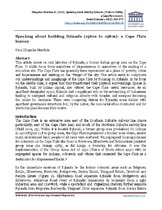| dc.contributor.author | Dhupelia-Mesthrie, Uma | |
| dc.date.accessioned | 2016-04-25T15:15:15Z | |
| dc.date.available | 2016-04-25T15:15:15Z | |
| dc.date.issued | 2014 | |
| dc.identifier.citation | Dhupelia- Mesthrie, U. (2014). Speaking about building Rylands (1960s to 1980s): a Cape Flats history. Social Dynamics, 40 (2): 353-370 | |
| dc.identifier.issn | 0253-3952 | |
| dc.identifier.uri | http://hdl.handle.net/10566/2149 | |
| dc.description.abstract | This article draws on oral histories of Rylands, a former Indian group area on
the Cape Flats. It shifts focus from narratives of dispossession to narratives of
the making of a relocation site. The Cape Flats has generally been represented as
a place of poverty, crime and hopelessness and existing on the 'fringe' of the
city. This article seeks to complicate our understandings and imaginings of the
Cape Flats by focusing on Rylands. In its focus on the middle class, it argues
that they transformed their physical surroundings. Spaces in Rylands, built by
Indian capital, also offered the Cape Flats useful resources. As an apartheid-designated space, Rylands had a significant role in the entrenching of Indianness
leading to energised cultural and religious activity with temples and mosques
becoming the centre for residents. There were competing visions for Rylands;
some dallied with apartheid governance structures but, by the 1980s, the nonracial
ethos dominated and for youth this place became their centre. | |
| dc.language.iso | en | |
| dc.publisher | Taylor and Francis | |
| dc.source.uri | http://dx.doi.org/10.1080/02533952.2014.932174 | |
| dc.title | Speaking about building Rylands (1960s to 1980s): a Cape Flats history | |
| dc.type | Article | |
| dc.privacy.showsubmitter | FALSE | |
| dc.status.ispeerreviewed | TRUE | |
| dc.description.accreditation | DHET | |

